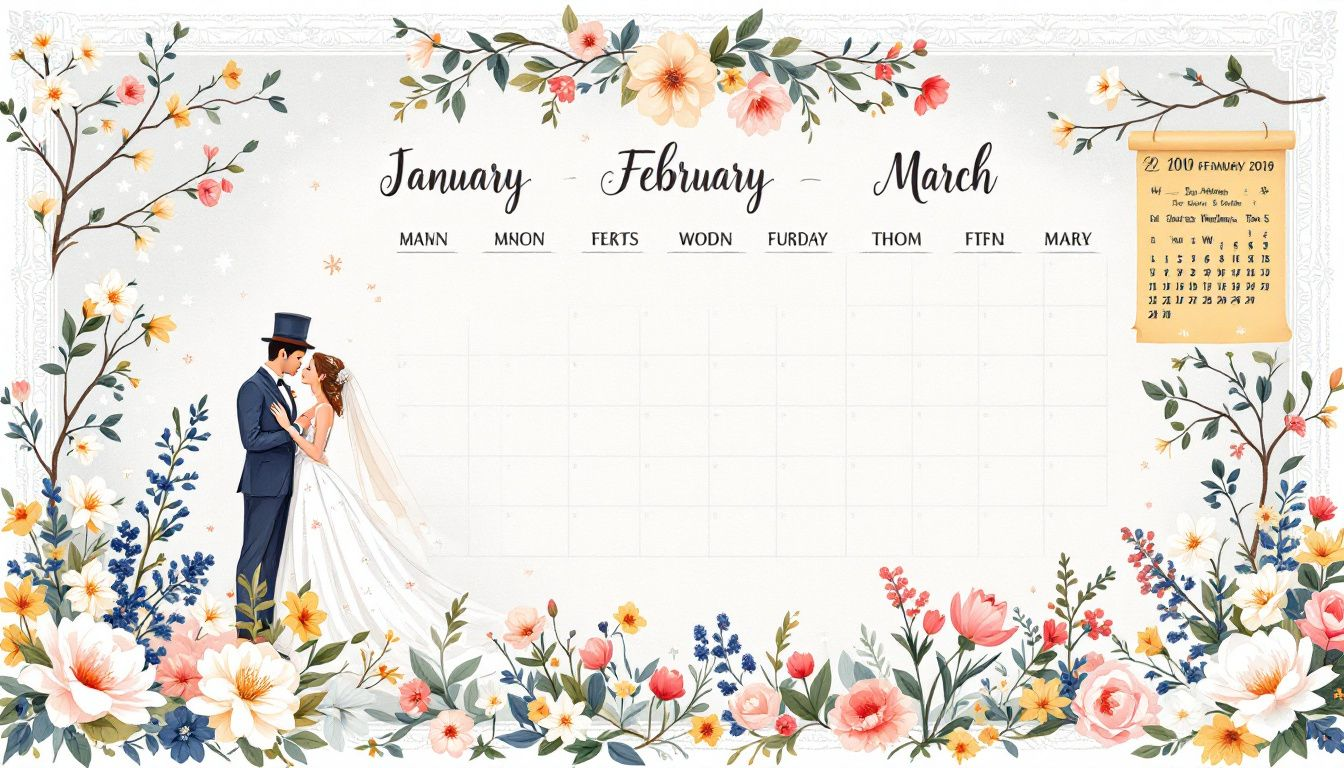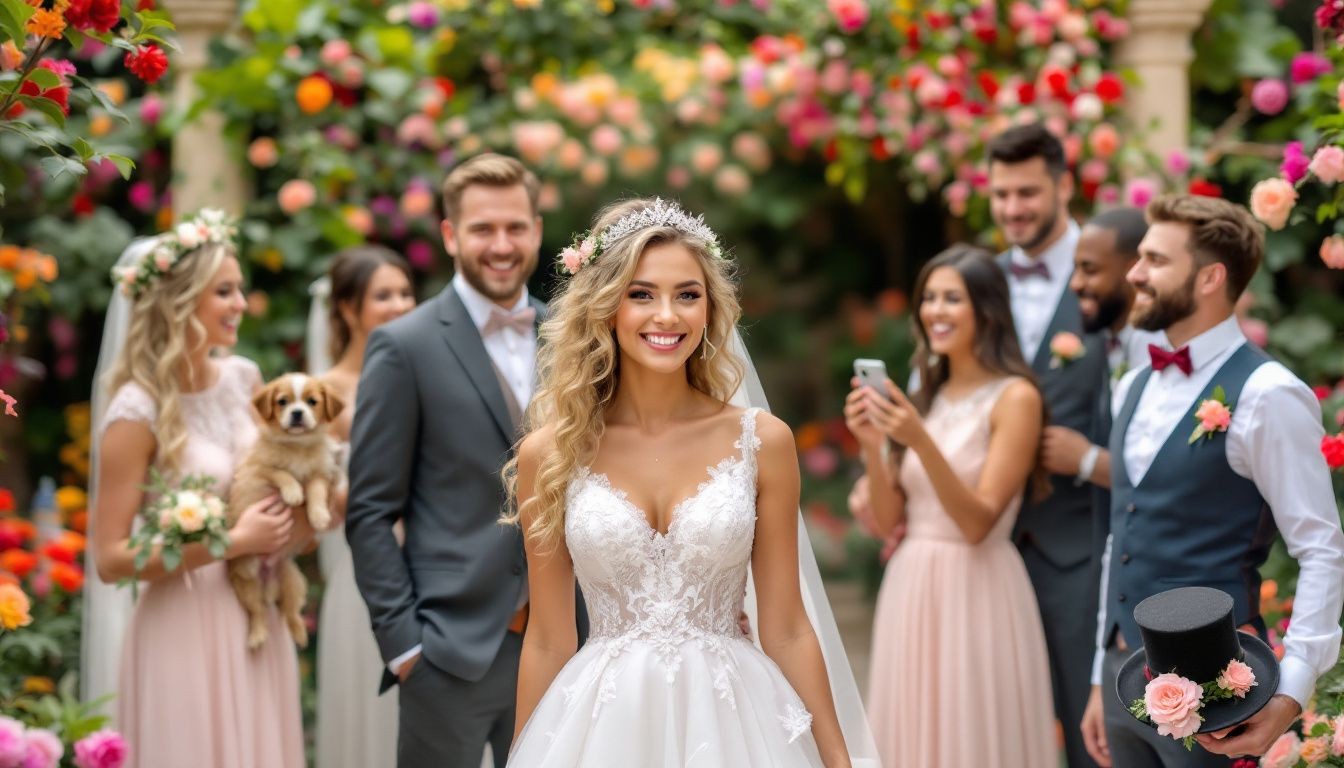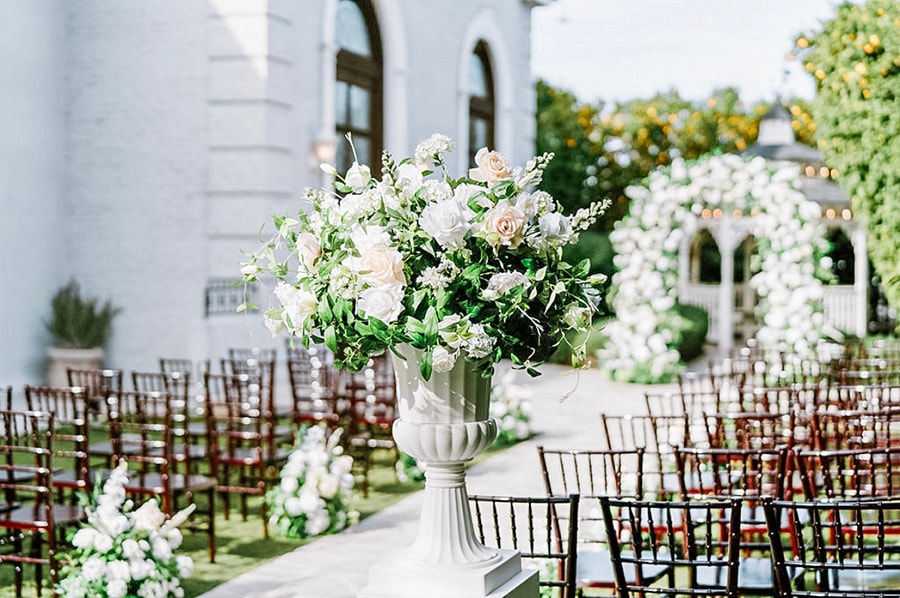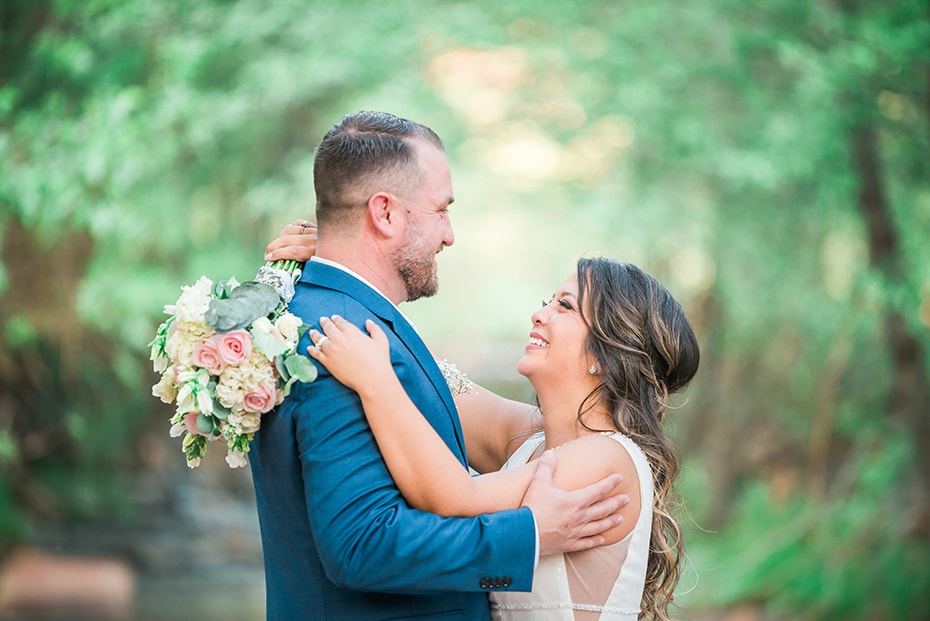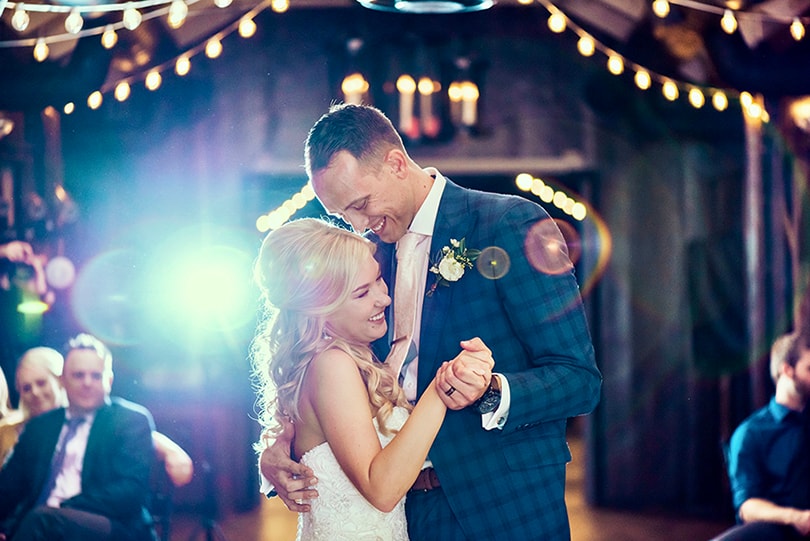Wondering how to plan a wedding? This guide will help you set your date, create a budget, choose a venue, and handle all the details from start to finish, ensuring your wedding ceremony is unforgettable.
Key Takeaways
-
Start your wedding planning by selecting a date that considers weather, venue availability, and costs for your wedding ceremony.
- Creating a realistic budget is crucial, so allocate funds to key areas and allow for unexpected expenses related to your wedding ceremony.
-
Assemble your bridal party thoughtfully and assign roles to ensure a smooth wedding ceremony and lasting memories.
Setting Your Wedding Date
Setting your wedding date is the first major step in your wedding planning journey, influencing everything from booking vendors to organizing logistics for your wedding ceremony. When choosing your date, consider the location and how different seasons might impact your wedding day weather. A picturesque outdoor ceremony in summer might be your dream, but keep in mind the possibility of sweltering heat or sudden rain showers.
Be mindful of local events and holidays, as they can impact venue availability and guest accommodations for your wedding ceremony. While a holiday weekend might appear convenient, it can increase costs and complicate travel for guests. Opting for a weekday often results in better venue availability and lower prices.
Getting married on personal anniversaries or significant dates can add extra meaning to your wedding ceremony, such as the anniversary of your first date or engagement.
Locking in your date early ensures you can book your dream venue and vendors before they are taken. With the date set, you can move on to creating your budget and other planning steps for your wedding ceremony.
Creating a Budget
Creating a realistic budget is key to successful wedding planning. While the average wedding in the U.S. costs around $33,000, expenses can vary based on location and personal preferences. Start by determining what aspects of your wedding ceremony are most important to you and allocate your budget accordingly. For example, you might want to reserve around 10% of your budget for flowers and decor, which includes bouquets and centerpieces for the wedding ceremony.
Allocate 5-15% of your budget for unexpected expenses to cover last-minute changes or additions and avoid surprises during your wedding ceremony. It’s also crucial to determine your budget for the venue early on, as this will be one of your most significant expenses.
Tools like spreadsheets or budget apps help track wedding expenses, allowing you to adjust and prioritize spending on the most important elements of your wedding ceremony.
Once your budget is set, you can confidently assemble your bridal party and proceed with your plans for the wedding ceremony.
Assembling Your Wedding Party
Assembling your bridal party is an exciting part of planning, as these individuals will support you and celebrate with you during your wedding ceremony. The bridal party typically includes bridesmaids, groomsmen, a flower girl, and a ring bearer. Each role comes with its own set of responsibilities and significance for the wedding ceremony.
The groom’s parents also play a significant role, often participating in the processional and recessional, adding to the family-oriented atmosphere of the wedding ceremony.
Bridesmaids and groomsmen support the bride and groom, assist with planning, and help on the wedding day. They are often close friends or family members who have shared significant moments in your life. Consider a personalized approach, like a heartfelt note or special gift, when asking someone to join your bridal party.
Including junior bridesmaids and junior groomsmen, who are typically aged 9-15, can add a special touch to your wedding ceremony. These young members of your bridal party can assist the adults and participate in the ceremony, making them feel included and valued. The flower girl, usually aged 3-8, has the charming task of scattering petals down the aisle, adding a touch of innocence and joy to the wedding ceremony.
Remember other roles like guest book attendants and sign bearers. Guest book attendants welcome guests and assist with the guest book, while sign bearers add a whimsical touch by carrying messages down the aisle during the wedding ceremony.
Carefully selecting your bridal party and assigning roles ensures all details are covered, helping your wedding ceremony run smoothly and creating lasting memories.
Choosing a Venue
The wedding venue sets the stage for your big day, so choose one that matches your theme and vision for your wedding ceremony. For example, a rustic wedding might suit an outdoor setting, while a luxury hotel fits a formal affair. Reading reviews from other couples who have used the venue can provide valuable insights into its quality and any potential issues.
Booking your venue well in advance provides more options and locks in current rates for your wedding ceremony. For outdoor weddings, discuss backup options for bad weather, like tents or indoor spaces. Trust your instincts regarding the venue’s atmosphere and the professionalism of the coordinator to guide your choice.
Ensure the venue’s capacity aligns with your guest list for a comfortable experience for all during the wedding ceremony. After choosing your venue, you can proceed to hire key vendors, confident you have the perfect backdrop for your wedding ceremony.
Hiring Key Vendors and Wedding Planner
Choosing the right vendors brings your wedding vision to life. Begin by securing a wedding planner, who can streamline the process and help negotiate better prices for your wedding ceremony. Given the post-pandemic shift, couples are now booking their vendors much earlier than before, so it’s crucial to act fast.
Book your wedding photographer shortly after the venue to ensure availability. Choose a photographer whose style you love, as they will capture your special moments during the wedding ceremony. Confirm your wedding caterer early, as food quality is crucial for guest satisfaction.
Decide early whether to hire a DJ or live band and research your options for your wedding ceremony. Double-check all vendor bookings and share the finalized timeline to ensure everyone is aligned on expectations and schedules.
With key vendors secured, focus on designing a ceremony that reflects your love story.
Designing Your Ceremony
Your wedding ceremony is an opportunity to create a meaningful and personal experience. The ceremony typically begins with the processional, where the wedding party walks down the aisle, followed by the bride. Refer to a wedding ceremony outline for guidance on the structure, whether it’s a traditional wedding ceremony, religious, or nondenominational, including a Catholic wedding ceremony.
For those planning a Hindu wedding, understanding the Hindu wedding ceremony order is crucial, as it involves elaborate rituals over several days, from the baraat to the final blessings.
Unique vows, significant music choices, and guest participation can make your wedding ceremony truly special. Adding a unity ceremony, like candle lighting or sand mixing, symbolizes your commitment and serves as a beautiful highlight.
Similarly, a Jewish wedding ceremony order includes specific rituals such as signing the ketubah and the bedeken, along with the processional and key ceremonial elements like the chuppah and the exchange of rings.
Including readers for chosen passages adds a personal touch to your wedding ceremony. Sign bearers with messages add charm and whimsy. The ceremony concludes with the recessional, where the couple walks back up the aisle, followed by the wedding party, marking the start of your new life together.
Expressing gratitude during the wedding ceremony for your supporters and blessings adds even more meaning to the event. With the ceremony designed, shift focus to selecting the perfect attire for your bridal party.
Plan the Ceremony Order
Planning the ceremony order is a crucial part of the wedding planning process, ensuring that your special day flows smoothly and reflects your unique style and cultural background. Here’s how to create a ceremony that’s both meaningful and memorable:
-
Determine the Type of Ceremony: Start by deciding on the type of ceremony you want. Whether you’re envisioning a traditional wedding ceremony, a non-denominational service, or a religious ceremony like a Catholic, Jewish, or Hindu wedding ceremony, this decision will guide the rest of your planning.
- Choose the Ceremony Structure: Outline the structure of your ceremony. Typically, this includes the processional, where the wedding party walks down the aisle, a welcome message, readings, the exchange of vows and rings, and the recessional. Each element should reflect your personal preferences and the tone you want to set for your wedding day.
- Select the Ceremony Participants: Decide who will play key roles in your ceremony. This includes your wedding officiant, members of your wedding party, and any readers who will share meaningful passages. Each participant adds a personal touch to your ceremony, making it even more special.
- Plan the Ceremony Music: Music sets the mood for your ceremony. Choose pieces for the processional, recessional, and any other moments where music will enhance the experience. Whether you opt for classical pieces, contemporary songs, or cultural music, ensure it resonates with you and your partner.
-
Consider the Ceremony Length: The length of your ceremony should be comfortable for both you and your guests. Take into account the number of readings, the type of ceremony, and the time of day. A well-paced ceremony keeps everyone engaged and ensures a memorable experience.
By thoughtfully planning each aspect of your ceremony order, you’ll create a seamless and heartfelt event that celebrates your love story.
Selecting Attire
Selecting attire for your bridal party is an opportunity to reflect your personal style and wedding theme. Modern weddings often feature mix-and-match bridesmaid dresses, allowing individual expression while maintaining a cohesive look for the wedding ceremony. Popular colors like blush and metallic hues create a romantic and opulent aesthetic.
The wedding venue can influence bridal party attire, with outfits harmonizing with the surrounding colors and scenery. For groomsmen, contemporary and relaxed options like skipping ties can add a personal touch while still looking polished for the wedding ceremony. Allowing each groomsman to wear a different suit creates a unique yet cohesive look.
Coordinating attire for the bridal party and groomsmen enhances the wedding theme and visual appeal during the wedding ceremony. With attire chosen, focus on crafting invitations that set the tone for your wedding.
Crafting Invitations
Creating your wedding invitations is an exciting step that sets the tone for your big day. Estimate the number of guests likely to attend; typically, you invite around 85% of projected attendees for a local wedding. Expect about 15% of invitees to decline, with higher rates for destination weddings.
Use virtual invitation services to streamline the RSVP process and reduce the risk of losing responses for your wedding ceremony. When emailing invitations, use BCC to maintain privacy and avoid overwhelming guests with ‘reply all’ responses. This approach ensures a smooth process, letting you focus on planning the reception.
Planning the Reception
Creating a seating chart and consulting with your venue on layout options based on guest count are key steps in planning the reception. Assigned seating streamlines dinner service, preferred by many venues for efficiency. Alternatively, assigning tables without specific seats offers guests some freedom while maintaining structure.
The size and shape of tables affect how many guests can be seated during the wedding ceremony. Grouping guests by how you know them simplifies the seating chart creation process and allows for smoother interactions. If children are attending, seat them at a separate kids’ table with engaging activities to keep them occupied.
Avoid a singles table to prevent awkwardness during the wedding ceremony. Clearly conveying table assignments helps guests find their seats quickly. Adjust seating arrangements to accommodate divorced parents by seating them at separate tables close to the action. Traditionally, the parents of the couple share a table at the reception, facilitating family connections.
Plan Decor and Design
The decor and design of your wedding ceremony play a pivotal role in creating a beautiful and memorable atmosphere. Here are some tips to help you plan the perfect setting for your big day:
-
Choose a Color Scheme: Start by selecting a color scheme that reflects your style and preferences. Whether you opt for classic whites, romantic blush tones, or bold, vibrant hues, your color scheme will set the tone for the entire ceremony.
- Select the Ceremony Flowers: Flowers add beauty and elegance to your wedding ceremony. Choose blooms that complement your color scheme and theme. Consider bouquets for the bridal party, centerpieces for the altar, and floral arrangements for the aisle.
- Plan the Ceremony Lighting: Lighting can transform your ceremony space. Decide on the type of lighting that best suits your venue and time of day. Soft, warm lighting creates a romantic ambiance, while brighter lights can highlight key areas of the ceremony.
- Consider the Ceremony Backdrop: The backdrop for your ceremony is a focal point that frames the moment you say your vows. Whether it’s a floral arch, a draped fabric, or a scenic view, choose a backdrop that enhances the overall aesthetic of your wedding.
-
Plan the Ceremony Seating: The seating arrangement is crucial for both comfort and aesthetics. Decide on the type of chairs, the layout, and any additional decor like aisle runners or chair sashes. Ensure the seating arrangement allows for a clear view of the ceremony for all guests.
By carefully planning the decor and design, you’ll create a stunning and cohesive look that enhances the beauty of your wedding ceremony.
Plan Photography and Videography
Capturing the memories of your wedding ceremony through photography and videography is essential. Here’s how to ensure you get the best shots and footage of your special day:
-
Choose the Ceremony Photographer: Select a wedding photographer whose style you love and who has experience capturing wedding ceremonies. Look at their portfolio to ensure their work aligns with your vision. A skilled photographer will capture the emotions and key moments of your ceremony beautifully.
- Select the Ceremony Videographer: A videographer will capture the movement and sound of your ceremony, preserving the moments you’ll want to relive. Choose a videographer with a style that complements your photographer’s work. Look for someone who can tell your story through their lens.
- Plan the Ceremony Photography Schedule: Work with your photographer to create a schedule that includes all the important moments, from the processional to the recessional. Plan for candid shots, posed portraits, and any special requests you have. A well-organized schedule ensures no moment is missed.
- Consider the Ceremony Videography Equipment: Discuss the equipment your videographer will use, including cameras, lighting, and sound equipment. High-quality equipment ensures clear, professional footage. Make sure they have backup equipment in case of technical issues.
-
Plan the Ceremony Photography and Videography Style: Decide on the style you want for your photos and videos. Whether you prefer a documentary style, traditional posed shots, or a mix of both, communicate your preferences to your photographer and videographer. This ensures the final product reflects your vision.
By carefully planning your photography and videography, you’ll have beautiful, lasting memories of your wedding ceremony to cherish for years to come.
Organizing Pre-Wedding Events
Pre-wedding events are a fun and meaningful part of the planning process. Engagement parties, typically hosted by the bride’s parents or a close friend, can occur within one to three months after the engagement. These gatherings allow you to celebrate your engagement with loved ones and set the stage for the wedding festivities.
A bridal shower is traditionally women-only, while a wedding shower includes both partners and their friends and family. Showers are a great way to gather with loved ones, receive gifts, and enjoy the pre-wedding excitement.
The rehearsal dinner, usually the night before the wedding, offers a relaxed atmosphere for families and the groom’s parents, as well as wedding party members to gather. Traditionally, the groom’s parents pay for the rehearsal dinner, though both sets of parents often contribute. Guests typically include immediate family, the wedding party, and sometimes the officiant and close friends. The groom’s parents often play a significant role in these events, particularly in hosting the rehearsal dinner, which brings together both families and the wedding party.
Organizing these events puts you well on your way to a memorable wedding ceremony.
Finalizing Details
As your wedding day approaches, finalize all the details and ensure you have included all essential information for the ceremony and reception in your ultimate checklist. The day before the wedding, check the schedule, gather necessary items, and ensure your car is fueled for the wedding ceremony.
Text the bride to confirm she’s ready and knows the schedule for the wedding ceremony. Double-check all vendor bookings and share the finalized timeline with them to ensure everyone is on the same page. This preparation will help alleviate any last-minute stress and ensure a smooth and enjoyable wedding ceremony.
With all the details finalized, you can relax and look forward to your special day, knowing that everything is in place for a memorable wedding ceremony.
Summary
Planning a wedding from start to finish involves many steps, but with careful planning and organization, it can be a smooth and enjoyable process. From setting your wedding date and creating a budget to assembling your bridal party and finalizing details, each step plays a crucial role in creating your dream wedding ceremony.
As you embark on this journey, remember to stay true to your vision and enjoy the process. Your wedding day is a celebration of your love story, and with the right planning, it will be a day to remember for a lifetime.
Frequently Asked Questions
How do you arrange a wedding ceremony?
To arrange a wedding ceremony, start with the processional and follow a structured order, including opening remarks, readings, vows, ring exchange, and unity ceremonies, ending with the recessional. The officiant often offers closing remarks and instructions to the wedding guests following the recessional, ensuring they know what to do next. This flow creates a meaningful and memorable experience for everyone involved.
When should I start setting my wedding date?
You should set your wedding date early in the planning process, as it affects vendor and venue bookings for your wedding ceremony. Think about things like weather, local events, and any personal significance to help you choose the perfect date.
How much should I budget for unexpected wedding expenses?
You should budget 5-15% of your total wedding budget for unexpected expenses related to your wedding ceremony. This cushion will help you handle any surprises that may pop up during planning.
What roles should I consider when assembling my wedding party?
When assembling your bridal party, think about including bridesmaids, groomsmen, a flower girl, and a ring bearer, as well as options like junior attendants and guest book attendants for an extra special touch during the wedding ceremony. The groom’s parents also play a significant role, often participating in the processional and recessional, adding to the family-oriented atmosphere of the wedding ceremony. Make it personal and enjoyable for everyone involved!
How can I ensure my wedding ceremony is personal
Ensuring your wedding ceremony is personal involves incorporating elements that reflect your unique love story and relationship. Start by writing your own vows, sharing personal anecdotes, and expressing your heartfelt promises to each other. This adds an intimate touch and allows your guests to witness the depth of your commitment.
Consider including meaningful rituals or traditions that resonate with you both. Whether it’s a unity ceremony, like candle lighting or sand mixing, or a cultural tradition, these elements can symbolize your bond and create lasting memories. Involving family members or close friends in the ceremony can also add a personal dimension, whether through readings, music, or as part of the bridal party.
Select music that holds special significance to your relationship, whether it’s the song that played during your first dance or a tune that reminds you of a cherished moment together. Personalizing the ceremony space with decor that reflects your style and shared interests can also enhance the atmosphere and make the event truly yours.
Finally, choose an officiant who understands your relationship and can tailor the ceremony to your preferences, ensuring that their words resonate with you and your guests. By incorporating these personal touches, your wedding ceremony will be a true reflection of your journey together, creating a memorable

